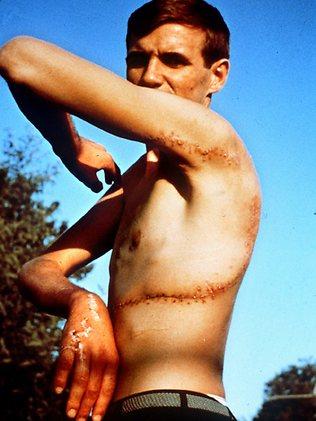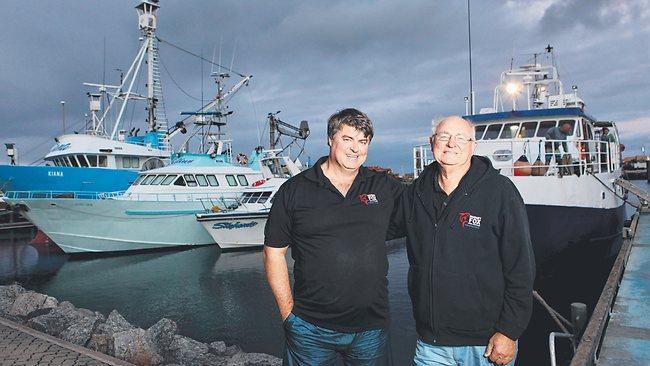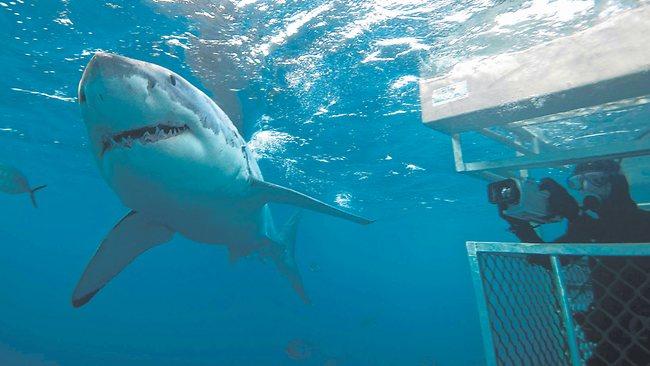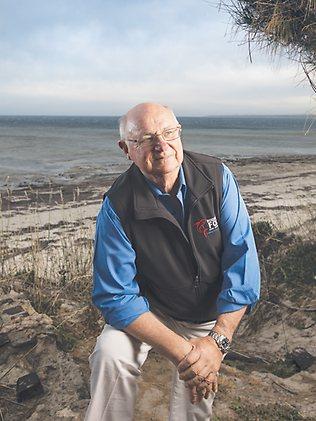Why Rodney Fox is the man who loves sharks
RODNEY Fox survived a Great White shark attack almost 50 years ago. Rather than scare him out of the water, it led to a career learning about them.
RODNEY Fox survived a Great White shark attack almost 50 years ago. Rather than scare him out of the water, it led to a career learning about them.
His finger poised over the trigger of the spear gun, Rodney Fox never took his eyes from the circling shark. For what seemed like hours, as the sun set over the water, the predator swam round and round him.
Not long before, it had attacked a friend Fox was spearfishing with, Brian Rogers. He had speared the shark and managed to get away, slowly swimming back to shore with a bleeding leg. But the underwater hunter shook out the shaft – and then turned its attention to Fox.
“I didn’t know (Brian) had been attacked, otherwise my heart would have stopped,” Fox recalls. “That shark circled me and circled me, almost sniffing to see if I was breathing. It seemed like for hours. I was very tired and frightened. I looked at my little rubber (spearfishing) gun and I looked at the shark but I was too scared to shoot it because I thought I’d upset it.”
This was Rodney Fox’s first face-to-face encounter with a shark but, as most South Australians know, it was not his last – nor his most frightening.
Fifty years ago on December 8, the now renowned shark expert was nearly killed by a Great White off Aldinga Beach. That near-fatal attack came a year-and-a-half after this interminable stand-off, from which Fox eventually escaped unscathed.
The near miss may well have saved his life as it prompted him to think about what he would do if he was ever the target of an ocean predator again.
“After Brian’s attack we discussed sharks in great detail,” 73-year-old Fox says. “We thought the most vulnerable spot on a shark ... was its eyes. That raced into my head when (the Great White) had hold of me – gouge its eyes.”
On that day in December Fox’s attacker nearly bit him in half, breaking every rib on the left side of his chest, puncturing a lung and exposing vital organs. It took four hours of surgery to save his life.
But instead of scaring him out of the water for good, the encounter sparked a curiosity in Fox – a life insurance salesman at the time – that led to a career dedicated to learning more about the animal that nearly killed him. He has travelled the world researching, diving with, and talking about Great White sharks.
In about 1965, he designed and built the first under water observation cage to dive with the creatures. Over the years his business grew into Rodney Fox Shark Expeditions, a company which takes tourists cage diving with Great Whites off Port Lincoln and conducts research.
Now a father of three and grandfather of eight, Fox has been involved in at least 70 films or documentaries over his career, including the Jaws movie which he now admits he was “a bit ashamed of having worked on at first”.
“We didn’t know it was going to frighten everybody out of the water,” he says. “But what it did was breed a whole lot of new people interested in finding out about sharks.”
Fox attributes the fascination and the fear we still have of sharks to a basic fear of being eaten alive. They are one of the last remaining high order predators with which humans have uncontrolled interaction.
“The lions, the tigers, the bears ... have been put behind bars and in national parks so humans don’t have a fear of being eaten alive by them like our ancestors did,” Fox says. “But when you go to see the last of the major predators, the shark, we haven’t got control over it.
“People look at the sea and they have no idea because our underwater vision is so small, there could be a shark anywhere.”
On December 8, 1963, Fox had been competing in a spearfishing competition at Aldinga Beach, about 65km south of Adelaide. He had returned to shore to unload a fish float full from three hours of fishing.
To get enough points to ensure he won the competition Fox wanted to go back out for a special fish. “I knew I needed a dusky morwong, which is a large weed eating fish. I knew the points for that would help tremendously,” he says.
He headed out to deeper water where he knew there would be few other divers. All the fishing activity in the area meant there was a lot of blood in the water.
“I dived down holding my breath. I saw the fish that would help me win. It had its head in a weed bed. I was drifting closer and closer, too close not to miss. I was just within split seconds of pulling the trigger when this huge thump, crash hit me.”

Fox remembers the force of the Great White biting into his left side felt like being hit by a train.
“It was swimming along with me in its mouth,” he says. “I gouged around its head and it sort of let me go. It stopped and I sort of fell out of its mouth and instinctively thrust my hand at it to push it away.
“But it went in its mouth, over its sharp teeth. Before it could close its mouth and bite my arm off I ripped it out. I thought what else can I do? I grabbed the shark around the belly ... thinking if I held on it can’t bite me.”
About this time, Fox realised he was holding his breath at least nine metres under water and if he didn’t act quickly he was going to drown. He took a chance, pushing away from the shark to swim for air.
When he finally reached the surface he took a huge breath before turning to look back into the water. What he saw is the stuff of nightmares.
“I looked down and the picture that remains ... was this great big head coming up with its mouth wide open and big white teeth through red blood,” he says.
What happened next was the first of three miracles Fox believes saved his life.
At the last second, the shark was distracted by the fish float loaded with Fox’s catch. However, it was connected by a rope to his belt and as the Great White seized the float it began to drag Fox back under water.
Then the second miracle – just as he was about to run out of breath, the line snapped.

“That gave me enough adrenaline to hold on but I didn’t know which way was up,” he says. “I remember like a leaf drifts down from a tree, starting to drift upwards. When I got to the surface I yelled out ‘Shark, shark’ in absolute terror.”
A boat crew which had seen the blood red-water came over to investigate and Fox “popped up in the middle of it”. They hauled him into the boat and rushed for the shore, where they put him in the back of a car that had been parked on the beach.
The car hurtled towards the Royal Adelaide Hospital while others ran to a nearby home to call for an ambulance. Halfway into town, Fox was transferred to the ambulance which received police traffic assistance as it rushed him to help.
“I was only semi-conscious, I’d lost so much blood,” Fox says. “To breathe was the biggest problem. My lung had collapsed and every time I would breathe it would gurgle. It was the hardest hour of my life to try and keep breathing.”
The shark’s teeth had torn through Fox’s wetsuit and woollen vest, tearing open his torso.
Photographs of him on the operating table show deep red gashes down his side and his innards exposed. His lung and diaphragm were punctured, his scapula pierced and the tendons, fingers and thumb of his right hand were shredded. He still has part of a Great White tooth embedded in his wrist.
In what Fox considers his third miracle, a main artery from his heart to his stomach was exposed – but left untouched.
“One nick and I would have been dead within minutes,” he says. “I’m actually just amazed I’m alive.”
Four hours on the operating table at the hands of Dr Justin Miller and 462 stitches later Fox was wheeled into the intensive care ward. Images of his injuries are still shown around the world as evidence of the survival of one of the most serious non-fatal shark attacks on record

If it was divine intervention that saved him, Rodney Fox certainly hasn’t wasted his second chance at life.
This August he and wife Kay celebrated their 50th wedding anniversary. This month Fox released a book on his life titled Rodney Fox: Sharks, the Sea and Me.
He regularly travels overseas to speak at conferences and is still involved in the Rodney Fox Shark Expeditions business.
“Its been a very interesting life over the past 50 years,” he says. “We’ve learned a tremendous amount about sharks since I was attacked.”
This weekend the expeditions crew will run an anniversary trip to the Neptune Islands off Port Lincoln where Fox plans to go cage diving and “have a laugh at the sharks” because he survived.
On the anniversary of his attack on December 8, he will return to the stretch of beach where he was attacked and venture into the water.
“I’ve only dived there twice since the attack,” he says. “I still have a bit of a bad feeling about it because it was such difficult memories.”
Despite his horrific injuries, Fox returned to the water just three months after he was mauled.
“To stay out of the water because of a fear of sharks is not a real fear, it’s a fear in your own head,” he says. “I think the underwater world is far, far more worthy to enjoy than the fear.”
He was extremely weak and barely recovered, so Fox had to rely on Kay – whom he had married only months before he almost died – to paddle him out on a surf ski to join a group of other spearfishers.
The moment he hit the water Fox was flooded with memories of the attack.
“I was spooked by the sun shining on the tops of the water, making little diamonds, and every one of those little diamonds was a shark in my mind,” he says.
“I remember saying to myself ‘Rodney, if you don’t get rid of them you’ll be no good’ and I had to sort of shake my head because I knew they weren’t sharks.”
He also reminded himself the numbers were in his favour. “I looked up the statistics. In those days only five or six people per year died from a shark attack. I had to say those things to myself regularly.
“I had to say ‘Sharks don’t actually like people, they prefer to eat their own food’.”
There have been 61 shark attacks in South Australian waters since 1836. Of those, 19 were fatal and all the deaths involved white sharks. Around Australia, Great Whites have been responsible for 69 deaths.
Experts say white sharks are inquisitive and will investigate objects in the water, like surfboards, humans or fish floats, usually by biting.

Of the 46 attacks in SA waters by white sharks, 42 involved just a single bite
Fox says before he was attacked Australians were “really primitive in our knowledge of sharks”. He has spent the past five decades trying to inform instead of scare.
Rodney Fox Shark Expeditions runs about 50 trips each year enabling intrepid tourists and researchers to safely observe the powerful hunters from inside a metal cage which hangs off the back of the boat. Jaws fans make up a large proportion of the clientele, as well as international scientists.
Celebrities, including popstar P!nk and actress Pamela Anderson, regularly visit the area world– renowned for its congregation of Great Whites. Fox says all types are attracted to the thrill of diving with sharks.
“The total variety of people we get on the boat; from little old ladies who’ve loved sharks all their life, to young kids who are fascinated, to science people, multi-millionaires who can just come any time they like, to backpackers who have saved all their money to come to Australia,” he says.
Even Fox’s 14-year-old grandson has done it. “He was like a little seal in there, it was wonderful,” Fox beams. “To see people come out of the cages totally excited – it certainly makes me feel like we’ve started something worldwide that is a unique thing.
“Once people have seen the sharks for themselves they realise that they are a different animal than they had in their minds. That’s what we try and get people to achieve when they come here."
As well as giving tourists a thrill, the company runs a research foundation which tags and tracks sharks.
During an expedition earlier this year, saweekend witnessed the tagging of a new female Great White.
Rodney’s son Andrew Fox runs much of the research operations. To tag a shark he stands unharnessed on the back of the boat using only the suspension in his knees to negotiate the rolling waves as he leans precariously out over the water.
He must expertly plunge a tag, stuck to the end of a pole, into the shark’s skin near its dorsal without overbalancing and falling in. In a successful attempt, the shark flinches only momentarily before swimming off unfazed.
Satellite tags are programmed to release after a certain period and float to the surface to transmit data via satellite about where the shark has been.
Acoustic tags send pings to receivers when a shark swims within about 400m. All sharks the crew encounter are also photographed and named for identification.
Some of the regulars are Annex, a 3.5m male, Blotchy, a whopping 4.8m female, Cowgirl, who measures 3.8m, and the comparatively tiny Charlotte at 2.5m. The research crew collaborate with international visitors and publish papers.
They are starting work on a project to monitor changes in the area around the Neptune Islands, which has been identified as a sanctuary zone under new state marine park laws.
The team has lobbied for years for greater protection for the area and now wants to see what changes in the environment result from a ban on fishing there.
They hope it will reduce the number of accidental hookings of smaller sharks.
Born a few years after his father’s shark attack, Andrew Fox saw his first Great White at age seven on a trip with his dad.
“It just seemed a natural part of life growing up,” he says. “Even looking at Dad’s big scars, it is only in the last few years I look at them and go, ‘oh my God that is a serious injury’.”
Andrew describes his father as “an original pioneering conservationist”.
“He didn’t ever come across early on as a shark hugger, but he did it through reason and good evidence and appreciation, admiration and respect for the animal,” he says.
“Nobody would understand why he didn’t want to kill sharks that he saw on his expeditions.
“Now when there’s a shark attack on, he feels terribly, not guilty, but he’s sort of ashamed that he loves sharks. His whole message is about overcoming fear to live your dreams. He’s pushed himself through that and that mentality has been an inspiration to lots of people.”
Rodney describes his early experience with shark science as the “cowboy days”.
“We were learning just to look at a shark and try and understand them a bit better,” he says.
“With satellite tagging and communications and all that now, its a different world. The science is improving so quickly, I’m being left behind.”
Although he has one suggestion for today’s scientists – he would like to see a device swimmers could
wear around their waist that would send out signals to deter sharks.
“This would give people so much confidence that they would be able to enjoy the underwater world and it would put a lot more people in the oceans,” he said.
Every year approaching summer, Rodney starts to receive phone calls from media outlets asking for comment on the latest shark sightings or attacks.
“They say ‘there’s a lot of sharks being seen out there, it’s going to be a bad year isn’t it?’,” he says.
“Whenever there’s a shark attack my stomach turns over and I feel the pain and the fear and the tension that it generates in people’s minds and hearts.
“I could have easily made a lot of headlines by saying controversial things, but I didn’t believe the sharks were that bad.
“I knew that the fear was in people’s minds ... I’ve just been trying to alleviate those fears over the years.”
From Monday, Advertiser subscribers can purchase a limited number of Rodney Fox’s autobiography Sharks, the sea and Me (Wakefield Press) for the special price of $24.95 from the News Shop, 31 Waymouth St, Adelaide. Ph 8206 3317.
THE GREAT WHITE SHARK
Scientific name: Carcharodon carcharias
Size: Measures up to 6m, can weigh up to three tonnes
Habitat: Coastal surface waters in all major oceans, including the southern coasts of Australia. Now a protected species across Australia and other countries including South Africa, the Maldives, Namibia, Israel and parts of the US.
Feeding: The Great White is the largest meat-eating shark. Its teeth are serrated like the blade of a bread knife and can measure more than 6.3cm. Teeth grow forward in rows, so when a tooth is lost, another replaces it. A shark may go through 10,000 teeth in a lifetime.
Hunting: White sharks migrate to SA waters to feed on seal and swim past populated beaches regularly. The Great White shark is able to cruise for hours at a time without tiring because its stout body remains fairly rigid, while the tail does the work. They can travel 80km a day. A Great White has been recorded as deep as 1100m underwater.
Breeding: Great Whites begin to breed at between 15 and 20 years of age. Females of this age average 5m in length. Females give birth to between seven and nine pups.
SHARK ATTACKS ON RECORD
The first record of a fatal attack in Australia was in 1791, when an Aboriginal woman was said to have been “bitten in two” at Port Jackson.
There have been 61 shark attacks in SA since 1836. Of the 46 SA people attacked by white sharks, 42 only sustained one bite.
Of all SA shark attacks, 19 were fatal and all fatalities involved Great White sharks.
An analysis of SA shark attacks shows 44 per cent happen in the summer months of December, January and February.
Great White sharks have been responsible for 69 deaths nationally.
Recent attacks
JULY 31, 2012: John Campion, 48, mauled while surfing with his daughter and friends near Streaky Bay. He suffered non-life threatening injuries to his upper body and right arm.
FEBRUARY 17, 2011: An abalone diver taken in an attack by two sharks, believed to be white pointers, while surfacing near Perforated Island, Coffin Bay.
AUGUST 24, 2005: Marine biologist Jarrod Stehbens, 23, taken by a shark, believed to be a white pointer, while diving for cuttlefish eggs with colleagues off Glenelg.
DECEMBER 16, 2004: Nick Peterson, 18, killed instantly when attacked by a Great White shark as he was towed behind a boat on a surfboard 300m off Adelaide’s West Beach.
APRIL 30, 2002: Scallop diver Paul Buckland, 23, dragged from a mate’s arms by a 6m white pointer while trying to get on board a boat in Smoky Bay in the Great Australian Bight.
Source: Shark Attack File, The Advertiser
